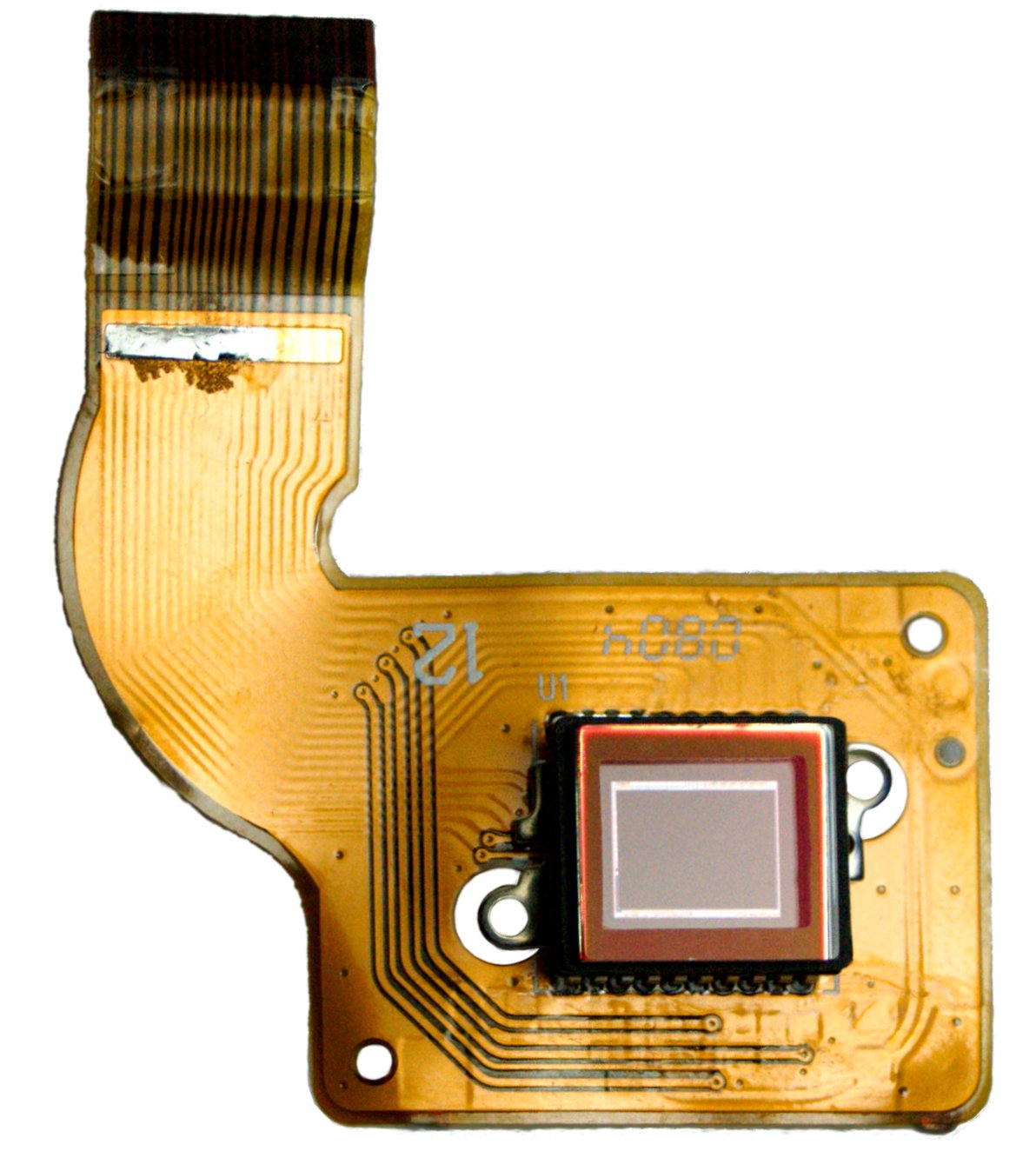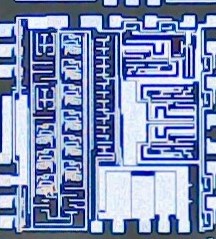|
CMOS
Complementary metal–oxide–semiconductor (CMOS, pronounced "sea-moss", ) is a type of metal–oxide–semiconductor field-effect transistor (MOSFET) fabrication process that uses complementary and symmetrical pairs of p-type and n-type MOSFETs for logic functions. CMOS technology is used for constructing integrated circuit (IC) chips, including microprocessors, microcontrollers, memory chips (including CMOS BIOS), and other digital logic circuits. CMOS technology is also used for analog circuits such as image sensors (CMOS sensors), data converters, RF circuits (RF CMOS), and highly integrated transceivers for many types of communication. The CMOS process was originally conceived by Frank Wanlass at Fairchild Semiconductor and presented by Wanlass and Chih-Tang Sah at the International Solid-State Circuits Conference in 1963. Wanlass later filed US patent 3,356,858 for CMOS circuitry and it was granted in 1967. commercialized the technology with the trademark "COS-MO ... [...More Info...] [...Related Items...] OR: [Wikipedia] [Google] [Baidu] |
CMOS Sensor
An active-pixel sensor (APS) is an image sensor where each pixel sensor unit cell has a photodetector (typically a pinned photodiode) and one or more active transistors. In a metal–oxide–semiconductor (MOS) active-pixel sensor, MOS field-effect transistors (MOSFETs) are used as amplifiers. There are different types of APS, including the early NMOS APS and the now much more common complementary MOS (CMOS) APS, also known as the CMOS sensor. CMOS sensors are used in digital camera technologies such as cell phone cameras, web cameras, most modern digital pocket cameras, most digital single-lens reflex cameras (DSLRs), and mirrorless interchangeable-lens cameras (MILCs). CMOS sensors emerged as an alternative to charge-coupled device (CCD) image sensors and eventually outsold them by the mid-2000s decade. The term ''active pixel sensor'' is also used to refer to the individual pixel sensor itself, as opposed to the image sensor. In this case, the image sensor is sometimes cal ... [...More Info...] [...Related Items...] OR: [Wikipedia] [Google] [Baidu] |
RF CMOS
RF CMOS is a metal–oxide–semiconductor (MOS) integrated circuit (IC) technology that integrates radio-frequency (RF), analog and digital electronics on a mixed-signal CMOS (complementary MOS) RF circuit chip. It is widely used in modern wireless telecommunications, such as cellular networks, Bluetooth, Wi-Fi, GPS receivers, broadcasting, vehicular communication systems, and the radio transceivers in all modern mobile phones and wireless networking devices. RF CMOS technology was pioneered by Pakistani engineer Asad Ali Abidi at UCLA during the late 1980s to early 1990s, and helped bring about the wireless revolution with the introduction of digital signal processing in wireless communications. The development and design of RF CMOS devices was enabled by van der Ziel's FET RF noise model, which was published in the early 1960s and remained largely forgotten until the 1990s. History Pakistani engineer Asad Ali Abidi, while working at Bell Labs and then UCLA during the 19 ... [...More Info...] [...Related Items...] OR: [Wikipedia] [Google] [Baidu] |
Image Sensor
An image sensor or imager is a sensor that detects and conveys information used to make an image. It does so by converting the variable attenuation of light waves (as they pass through or reflect off objects) into signals, small bursts of current that convey the information. The waves can be light or other electromagnetic radiation. Image sensors are used in electronic imaging devices of both analog and digital types, which include digital cameras, camera modules, camera phones, optical mouse devices, medical imaging equipment, night vision equipment such as thermal imaging devices, radar, sonar, and others. As technology changes, electronic and digital imaging tends to replace chemical and analog imaging. The two main types of electronic image sensors are the charge-coupled device (CCD) and the active-pixel sensor (CMOS sensor). Both CCD and CMOS sensors are based on metal–oxide–semiconductor (MOS) technology, with CCDs based on MOS capacitors and CMOS sensors based on M ... [...More Info...] [...Related Items...] OR: [Wikipedia] [Google] [Baidu] |
Nonvolatile BIOS Memory
Nonvolatile BIOS memory refers to a small Memory (computers), memory on personal computer, PC motherboards that is used to store BIOS settings. It is traditionally called CMOS RAM because it uses a volatile memory, volatile, low-power CMOS, complementary metal-oxide-semiconductor (CMOS) Static random access memory, SRAM (such as the Motorola MC146818 or similar) powered by a small "CMOS" battery when system and standby power is off. It is referred to as non-volatile memory or Non-volatile random-access memory, NVRAM because, after the system loses power, it does retain state by virtue of the CMOS battery. The typical NVRAM capacity is 256 bytes. The CMOS RAM and the real-time clock have been integrated as a part of the Southbridge (computing), southbridge chipset and it may not be a standalone chip on modern motherboards. In turn, the southbridge have been integrated into a single Platform Controller Hub. Today's UEFI motherboards use NVRAM to store configuration data (NVRAM i ... [...More Info...] [...Related Items...] OR: [Wikipedia] [Google] [Baidu] |
Mixed-signal
A mixed-signal integrated circuit is any integrated circuit that has both analog circuits and digital circuits on a single semiconductor die."ESS Mixed Signal Circuits" Their usage has grown dramatically with the increased use of , , portable electronics, and automobiles with electronics and digital sensors. Overview |
Integrated Circuit
An integrated circuit or monolithic integrated circuit (also referred to as an IC, a chip, or a microchip) is a set of electronic circuits on one small flat piece (or "chip") of semiconductor material, usually silicon. Large numbers of tiny MOSFETs (metal–oxide–semiconductor field-effect transistors) integrate into a small chip. This results in circuits that are orders of magnitude smaller, faster, and less expensive than those constructed of discrete electronic components. The IC's mass production capability, reliability, and building-block approach to integrated circuit design has ensured the rapid adoption of standardized ICs in place of designs using discrete transistors. ICs are now used in virtually all electronic equipment and have revolutionized the world of electronics. Computers, mobile phones and other home appliances are now inextricable parts of the structure of modern societies, made possible by the small size and low cost of ICs such as modern computer ... [...More Info...] [...Related Items...] OR: [Wikipedia] [Google] [Baidu] |
MOSFET
The metal–oxide–semiconductor field-effect transistor (MOSFET, MOS-FET, or MOS FET) is a type of field-effect transistor (FET), most commonly fabricated by the controlled oxidation of silicon. It has an insulated gate, the voltage of which determines the conductivity of the device. This ability to change conductivity with the amount of applied voltage can be used for amplifying or switching electronic signals. A metal-insulator-semiconductor field-effect transistor (MISFET) is a term almost synonymous with MOSFET. Another synonym is IGFET for insulated-gate field-effect transistor. The basic principle of the field-effect transistor was first patented by Julius Edgar Lilienfeld in 1925.Lilienfeld, Julius Edgar (1926-10-08) "Method and apparatus for controlling electric currents" upright=1.6, Two power MOSFETs in V_in_the_''off''_state,_and_can_conduct_a_continuous_current_of_30 surface-mount_packages._Operating_as_switches,_each_of_these_components_can_su ... [...More Info...] [...Related Items...] OR: [Wikipedia] [Google] [Baidu] |
Transistor–transistor Logic
Transistor–transistor logic (TTL) is a logic family built from bipolar junction transistors. Its name signifies that transistors perform both the logic function (the first "transistor") and the amplifying function (the second "transistor"), as opposed to earlier resistor–transistor logic (RTL) and diode–transistor logic (DTL). TTL integrated circuits (ICs) were widely used in applications such as computers, industrial controls, test equipment and instrumentation, consumer electronics, and synthesizers. After their introduction in integrated circuit form in 1963 by Sylvania Electric Products, TTL integrated circuits were manufactured by several semiconductor companies. The 7400 series by Texas Instruments became particularly popular. TTL manufacturers offered a wide range of logic gates, flip-flops, counters, and other circuits. Variations of the original TTL circuit design offered higher speed or lower power dissipation to allow design optimization. TTL devices were original ... [...More Info...] [...Related Items...] OR: [Wikipedia] [Google] [Baidu] |
Digital Logic
A logic gate is an idealized or physical device implementing a Boolean function, a logical operation performed on one or more Binary number, binary inputs that produces a single binary output. Depending on the context, the term may refer to an ideal logic gate, one that has for instance zero rise time and unlimited fan-out, or it may refer to a non-ideal physical device (see Ideal and real op-amps for comparison). Logic gates are primarily implemented using diodes or transistors acting as switch#Electronic switches, electronic switches, but can also be constructed using vacuum tubes, electromagnetic relays (relay logic), fluidic logic, pneumatics#Pneumatic logic, pneumatic logic, optics, molecular logic gate, molecules, or even analytical engine, mechanical elements. Now, most logic gates are made from MOSFETs (metal–oxide–semiconductor field-effect transistors). With amplification, logic gates can be cascaded in the same way that Boolean functions can be composed, allowing t ... [...More Info...] [...Related Items...] OR: [Wikipedia] [Google] [Baidu] |
Digital Electronics
Digital electronics is a field of electronics involving the study of digital signals and the engineering of devices that use or produce them. This is in contrast to analog electronics and analog signals. Digital electronic circuits are usually made from large assemblies of logic gates, often packaged in integrated circuits. Complex devices may have simple electronic representations of Boolean logic functions. History The binary number system was refined by Gottfried Wilhelm Leibniz (published in 1705) and he also established that by using the binary system, the principles of arithmetic and logic could be joined. Digital logic as we know it was the brain-child of George Boole in the mid 19th century. In an 1886 letter, Charles Sanders Peirce described how logical operations could be carried out by electrical switching circuits.Peirce, C. S., "Letter, Peirce to A. Marquand", dated 1886, '' Writings of Charles S. Peirce'', v. 5, 1993, pp. 541–3. GooglPreview See Burks, ... [...More Info...] [...Related Items...] OR: [Wikipedia] [Google] [Baidu] |
Chih-Tang Sah
Chih-Tang "Tom" Sah (; born in November 1932 in Beijing, China) is a Chinese-American electronics engineer and condensed matter physicist. He is best known for inventing CMOS (complementary MOS) logic with Frank Wanlass at Fairchild Semiconductor in 1963. CMOS is now used in nearly all modern very large-scale integration (VLSI) semiconductor devices. He was the Pittman Eminent Scholar and a Graduate Research Professor at the University of Florida from 1988 to 2010. He was a Professor of Physics and Professor of Electrical and Computer Engineering, emeritus, at the University of Illinois at Urbana-Champaign, where he taught for 26 years (1962-1988) and guided 40 students to the Ph.D. degree in electrical engineering and in physics and 34 MS EE theses. At the University of Florida, he guided 10 doctoral theses in EE. He has published more than 300 peer-reviewed journal articles with his graduate students and research associates, and presented about 200 invited lectures and 60 con ... [...More Info...] [...Related Items...] OR: [Wikipedia] [Google] [Baidu] |
CMOS Inverter
In digital logic, an inverter or NOT gate is a logic gate which implements logical negation. It outputs a bit opposite of the bit that is put into it. The bits are typically implemented as two differing voltage levels. Description The NOT gate outputs a zero when given a one, and a one when given a zero. Hence, it inverts its inputs. Colloquially, this inversion of bits is called "flipping" bits. As with all binary logic gates, other pairs of symbols such as true and false, or high and low may be used in lieu of one and zero. It is equivalent to the logical negation operator (¬) in mathematical logic. Because it has only one input, it is a unary operation and has the simplest type of truth table. It is also called the complement gate because it produces the ones' complement of a binary number, swapping 0s and 1s. The NOT gate is one of three basic logic gates from which any Boolean circuit may be built up. Together with the AND gate and the OR gate, any function in binary m ... [...More Info...] [...Related Items...] OR: [Wikipedia] [Google] [Baidu] |

.jpg)



.jpg)

